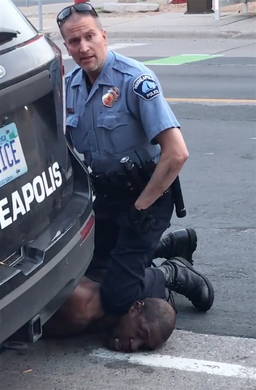In the article below, California State University, Fresno, History and Africana Studies professor Malik Simba briefly examines the life and death of George Floyd and how the latter transformed the struggle for racial justice in and beyond the United States.
George Floyd died on Memorial Day, May 25, 2020, on a Minneapolis, Minnesota street. He was suffocated to death by Minneapolis police officer Derek Chauvin, who calmly held his knee on Floyd’s neck for over nine minutes. Video of the incident quickly went viral, sparking anger, outrage, and indignation on a global scale. Except for the videotaping of the incident, George Floyd’s death might have gone unnoticed. It did not, and the world changed because of it.
At 8:08 p.m. on Memorial Day, Minneapolis police officers Thomas K. Lane and J. Alexander Keung responded to a call from the Cup Food Store on the corner of E. 38th Street and Chicago Avenue that Floyd was allegedly attempting to pass a counterfeit twenty-dollar bill. In a later interview, owner Mike Abumayyaleh stated that Floyd was a regular and pleasant customer and may not have realized that the bill was counterfeit.
Officers Lane and Keung found Floyd, 46, of St. Louis Park, a Minneapolis suburb, in the driver’s seat of a nearby car with a passenger, Maurice Hall. Lane pointed his gun at Floyd and then re-holstered it when Floyd placed his hands on the steering wheel. He ordered Floyd out of the car and handcuffed him. At 8:14 p.m. Lane (white) and Keung (black) walked Floyd to their police vehicle and tried to put him inside. Floyd resisted, telling the officers, “I am claustrophobic.”
At that point Minneapolis Police Officers Derek Chauvin (white) and Tou Thao (Hmong-Asian American) arrived at the scene in a separate police vehicle. All four officers tried unsuccessfully to get Floyd in the back seat of the first vehicle. At 8:19 p.m. Chauvin pulled Floyd out of the vehicle and forced him face down on the pavement while still handcuffed. Keung put pressure on Floyd’s back while Lane restrained his legs and Chauvin placed his knee on Floyd’s neck. Thao retrieved a restraint from the police vehicle to control Floyd, but the officers opted not to use it. Thao then turned his attention to several bystanders who had gathered to watch the incident including some who were videotaping it on their cell phones. He acted as a barrier between bystanders, Chauvin, and the now powerless Floyd to prevent any interference. As Floyd murmured, “I can’t breathe,” bystanders began to repeat these words to the officers, pleading for mercy for the man clearly in distress.
Despite protests from the bystanders, Floyd’s own words that he could not breathe, his cry for his deceased mother, his statement: “I’m about to die,” and Officer Lane’s suggestion that Floyd be turned over, Chauvin, the senior officer on the scene, refused to remove his knee, saying was Floyd was “staying put where we got him.” As Chauvin suffocated George Floyd, he casually looked at the cellphone cameras recording him, placed his left hand in his pocket, and continued to apply deadly pressure until well after Floyd had stopped breathing. Floyd was already dead when Chauvin finally removed his knee. Bystanders videotaping the entire episode ensured, however, that the world would view the last minutes of Floyd’s life.
George Floyd was born on October 14, 1973, in Fayetteville, North Carolina. His parents, George Perry Floyd and Lacenia Jones, had four other children. The parents separated when George was a young child, and Lacenia Jones moved to Houston, Texas, where she raised her children in a public-housing complex called “The Bricks,” located in the poorest section of Houston’s Third Ward. Floyd attended Jack Yates High School, graduating in 1993. During his high school years, he was an accomplished basketball and football player, a member of the Yates football team that competed for the Texas state football championship in 1992.
Standing at 6 feet 4 inches tall, Floyd received a football scholarship in 1993 to attend South Florida Community College in Avon Park, Florida, before he transferred to Texas A & M University-Kingsville in 1995 and where he remained through part of the 1997 school year. He interacted with players on the football team, but his name does not appear on the team roster.
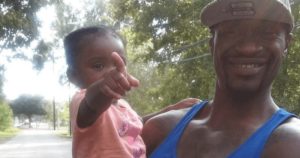
Courtesy GoFundMe, Fair use image
Twenty-two-year-old George Floyd’s life began to unravel when he returned to Houston from Kingsville. He, like many young Black men who had played college sports but were not talented enough for professional sports teams, tried his hand at becoming a rapper, adopting the name “Big Floyd.” He was also a member of the hip-hop group “Screwed up Clicks.” Unfortunately, Floyd’s life spiraled out of control; and between 1997 and 2005, he spent part of these years behind bars for theft, criminal trespass, and possession of a controlled substance. In 2007 he and others committed an armed home invasion and threatened the pregnant homeowner. For this Houston crime, he was sentenced in 2009 to five years in state prison. He was paroled in 2013.
After his release, Floyd returned to his old neighborhood and joined Resurrection Houston, a Christian ministry which operated outreach programs in the Third Ward. Floyd delivered meals and ministered to impoverished Third Ward residents. His continuing interest in music led him to local rapper “Trae Tha Truth” (Frazier Othel Thompson, III), who had created his own care-giving outreach program called the Angel by Nature Foundation, which Floyd joined. In 2013 tragedy struck when Floyd’s mother, Lacenia Jones, had a stroke. While continuing his work with Angel by Nature, Floyd was able to tend to his ailing mother until she recovered. She died in 2018.
In 2014, Floyd moved to Minneapolis, Minnesota, to pursue new opportunities. He worked in various jobs, including truck driver and nightclub bouncer. In an ironic twist of fate, in 2020, Floyd began working as a bouncer at El Nuevo Rodeo Club, the nightclub where his eventual murderer, Derek Chauvin, also moonlighted as a security guard. Meanwhile, in 2017, Floyd continued his self-rehabilitation by participating in the filming of a short video on preventing gun violence.
George Floyd’s murder on Memorial Day, 2020, added to the long list of deaths at the hands of police and vigilante violence against unarmed black women and men. Since the beginning of the 21st Century (since 2001), hundreds have been killed. Many of the names are familiar: Trayvon Martin, Michael Brown, twelve-year-old Tamir Rice, Sandra Bland, and Eric Garner. The deaths occurred in every corner of the United States. In 2020 we saw the deaths of Ahmaud Arbery, Breonna Taylor, and Rayshard Brooks among many others. Each of these deaths and those of other victims led to protests and in some instances to riots/ urban uprisings in specific cities.
The death of George Floyd was far greater in magnitude and impact. That murder was especially shocking because a videotape of the incident showed a policeman’s knee on Floyd’s neck as he cried out, “I can’t breathe” numerous times before he died. The publicly humiliating nature of his death struck a visceral nerve among African Americans, with the policeman’s knee symbolically representing the knee on the necks of all black people. For the first time, many non-black people also recognized the racial symbolism as reflecting the centuries-long and currently ongoing black oppression in the United States.
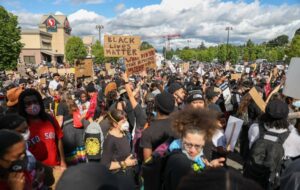
Courtesy Alex Garland, Fair use image
Floyd’s murder almost immediately generated protests that continued in some cities into September 2020. It led to the Black Lives Matter (BLM) movement being supported, according to national polls, by the majority of Americans for the first time in the organization’s seven-year history. By conservative estimates, these protests have involved more than 26 million Americans in 2,000 cities and towns in every state in the United States, making these the most widespread protests around one issue in the history of the nation. By the end of June alone, one month into the protests, 14,000 people had been arrested.
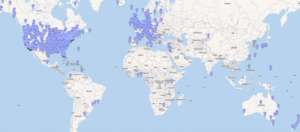
Similar protests have taken place in more than 60 nations on every continent except Antarctica despite the ongoing global COVID-19 pandemic. Protesters have marched in Istanbul, Turkey; Nairobi, Kenya; Tel Aviv, Israel; Toronto, Canada; Rio de Janeiro, Brazil; and Auckland, New Zealand. The overseas protests have often tied the Floyd murder to similar violence in local communities. In Rio’s impoverished “favelas,” thousands marched not only for Floyd but also for the hundreds of police killings in their communities. In Paris, the police killing of a Parisian-Arab, Adama Traoe, while in police custody, led thousands to march. Traoe’s sister, Assa, spoke at one rally and said, “What is happening in the United States is happening in France. Our brothers are dying.” Protesters in Sidney, Australia, combined their outrage over Floyd’s death with the 2015 death of an Aboriginal man, David Dugay, who was handcuffed by police, laid upon the sidewalk, and suffocated. Dugay was heard to say the now infamous words, “I can’t breathe, please let me up, I can’t breathe.”
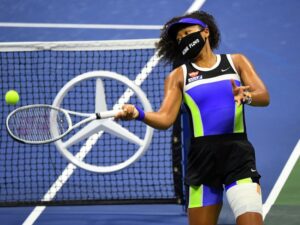
Courtesy Robert Deutsch/USA Today, Fair use image
Japan entered the George Floyd protest campaign on August 27, 2020 when its number-one female tennis player, Naomi Osaka, whose father is Haitian and mother is Japanese, refused to play in a semi-final match of the New York Western and Southern Open. The directors of the tournament postponed all matches for that day; and when they resumed, Osaka wore a Black Lives Matter tee-shirt while winning her semi-final match. Osaka continued her support for the Black Lives Matter movement when she, on August 31, 2020, arrived at her first match at the U.S. Open wearing a COVID-19 black mask with “Breonna Taylor” printed in white lettering.
Professional sports leagues, including the National Basketball Association (NBA), Major League Baseball (MLB), the National Hockey League (NHL), and the National Association for Stock Car Auto Racing (NASCAR), all conducted at least a one-day pause in their play to honor the memory of George Floyd. NASCAR’s only Black driver, Bubba Wallace, adorned his iconic number 43 (Richard Petty) car with Black Lives Matter etched in bold black. Black Formula 1 (FIA) champion, Lewis Hamilton, protested in London and the Women’s National Basketball Association (WNBA) players also protested and dedicated their season to Breonna Taylor with the slogan, “Say Her Name” in solidarity with George Floyd. They also wore white tee-shirts with seven bullet holes in the back as a tribute to Jacob Blake who was shot but not killed by Kenosha, Wisconsin police in August 2020.
The NBA, during the 2020 playoffs, adorned its “bubble” court in the quarantined Orlando playoff arena with a huge Black Lives Matter logo, and almost all players had logos on their jerseys such as “Freedom,” “Equality,” “Justice,” “Say Her Name,” “Vote,” or simply “Black Lives Matter.” Jamal Murray, a Denver Nugget star, had a picture of Breanna Taylor on his left basketball shoe and on the right, a picture of George Floyd. A number of the European NBA players also had Black Lives Matter logos in their native languages. Slovenian player Luka Doncic had ENAKOPRAVNOST on his jersey, which in his language means Equality.
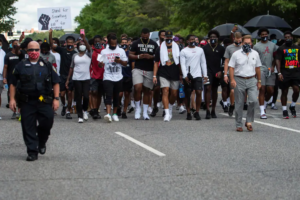
On September 1, 2020, even in politically conservative Alabama, the University of Alabama’s head coach, Nick Saban, led his players, with arms locked, on a Black Lives Matter march through the campus. The players released a statement that said, “All lives can’t matter until Black Lives Matter.” Coach Saban, standing in the spot where Alabama Governor George Wallace in 1963 said “segregation now, segregation tomorrow, segregation forever,” while trying unsuccessfully to keep black students out of the institution, uttered different words in 2020: “We are a team, Black, White, Brown. Together, we are a family. We are brothers who represent ourselves, our families, our hometowns, our university, and our country.”
The magnitude of these domestic and overseas protests prompted police reforms at the local, state, national levels. The most significant piece of legislative reform came in June 2020 when U.S. Congresswoman Sheila Jackson Lee, who represents George Floyd’s old Houston neighborhood in Congress, introduced the George Floyd Law Enforcement Trust and Integrity Act, which makes it illegal for police to use deadly choke holds and modifies the legal protection for police called “qualified immunity.”
As millions of people throughout the world took a symbolic knee for George Floyd by marching in unity, chanting “No Justice, No Peace” his murder led many voices, once silent on police misconduct, to speak or to act with their checkbooks. Basketball superstar and now Charlotte Hornets owner Michael Jordan, pledged $100 million to social justice organizations, and rapper Nick Cannon produced a George Floyd “I Can’t Breathe” video followed by a video from the rapper Common and along with singer John Legend. The proceeds from these sales were directed toward the Floyd family and the attorneys who represented him.
Corporate America responded to the George Floyd murder as well with a variety of initiatives. Hundreds of corporations and far more smaller companies donated millions of dollars to Black Lives Matter and other social justice organizations. Microsoft, for example, immediately gave $1.5 million to these organizations. PayPal and the Japanese conglomerate SoftBank created $500 million and $100 funds respectively to invest in black-owned businesses while YouTube invested $100 million to support and promote the work of black creators and artists, and the bicycle manufacturer, Trek, pledged $5 million to create bike shops in underserved communities to employ African Americans. Adidas pledged to fill 30% of all open positions with black or Latino candidates with Facebook and Estee Lauder and PepsiCo pledging smaller percentages. Amazon placed a one-year moratorium on the sale of facial recognition software to police departments while rival IBM stopped such sales permanently. Employees at Nike, Twitter, Target, General Motors and the NFL received Juneteenth off for the first time as a paid holiday.
Inspired by the George Floyd Mural painted on the wall of Cup Foods in Minneapolis, just above the spot where Floyd was killed, similar mural tributes emerged in cities across the United States and in European cities including Paris, France; Berlin, Germany; London, England; Madrid, Spain; Dublin, Ireland; Copenhagen, Denmark; and Athens, Greece.
Floyd’s murder generated public discussions ranging from various media outlets to schools and universities, churches, mosques, and synagogues as well as among city councils and state legislatures regarding broader issues of racial and social justice such as ending poverty, providing reparations, removing Confederate statues, enacting immigration reform, addressing the airing of racist films such as Gone with the Wind, and renaming military bases from Confederate heroes to civil rights heroes and, of course, reforming criminal justice and restructuring how police funding will be allocated.
While these national and international events have played out, the indictment of Officer Derek Chauvin and his fellow officers has proceeded slowly. Initially, the Hennepin County District Attorney’s Office charged Chauvin with third-degree manslaughter. However, after a public outcry about the leniency of this charge, Minnesota’s Attorney General, Keith Ellison, who in 2018 became the first African American to be elected to that post in his state, upgraded Chauvin’s indictment to second- degree murder. Other officers on the scene, J. Alexander Keung, Thomas K. Lane and Tou Thao, were also charged with aiding and abetting second-degree murder. All four officers were fired. On June 8, 2020, George Floyd was buried next to his mother in Pearland, Texas.
On Monday, March 29, 2021, almost 10 months after Floyd’s funeral, Derek Chauvin went on trial for the killing of George Floyd. He was charged with second-degree murder which carries a maximum of forty-years, third-degree murder which carries a maximum of 25 years, and second-degree manslaughter which carries a maximum of ten years. The twelve-person jury was composed of six white jurors, six black jurors and two multiracial jurors. Seven were women and five were men. The prosecution called 38 witnesses many of whom were at Cup Foods and witnessed the killing while the defense called just seven witnesses.
Hennepin County Prosecuting Attorney Jerry Blackwell in his opening statement said Chauvin “. . . betrayed his badge when he used excessive and unreasonable force on the body of George Floyd . . . grinding and crushing him until the very breath…the very life was squeezed out of him.” The Hennepin County examiner’s autopsy confirmed Blackwell’s statement while citing Floyd’s poor cardiac condition due to age and drug use. One expert pulmonologist, Dr. Martin Tobin, stated that Floyd died from a “low level of oxygen” because of Chauvin’s knee on Floyd’s neck.
The most important prosecution witness was seventeen-year-old, Danella Frazier who video recorded all nine minutes and twenty-nine seconds of the ending of George Floyd’s life. Frazier testified that “When I look at George Floyd, I look at my dad, I look at my brother, I look at my cousin and my uncle.” Her nine-year old cousin, Judea Reynolds who also witnessed the event, testified “I was sad and kind of mad and it felt like it was stopping him from breathing and it was hurting him.”
Her nine-year-old cousin, Judea Reynolds, who also witnessed the event, gave this testimony in trial, “I was sad and kind of mad and it felt like it [Chauvin’s knee] was stopping him from breathing and it was hurting him.” Several other teenagers testified and confirmed Reynolds’ observation. Another important prosecution witness, Genevieve Hansen, an off-duty EMT, who stopped to give aid to Floyd but was waved off by arresting officers, said on the witness stand while gently wiping tears from her eyes, “There is a man being killed.”
The Blue Wall of silence was also broken. For the first time in a case involving an officer killing an unarmed black person, a number of police officers testified against Chauvin, asserting that his actions were not remotely appropriate given the context of the arrest. The most important policeman to testify was Minneapolis Chief of Police, Medaria Arradondo who said of what Chauvin did, “It’s not a part of our training and is certainly not a part of our ethics or values.”
After three weeks of testimony, the trial concluded with prosecutor Jerry Reynolds closing with the phrase, “It has been argued that Mr. Floyd died because his heart was too big, but the truth of the matter is that he died because Mr. Chauvin’s heart was too small.”
During the trial U.S. President Joe Biden stayed in constant contact with the Floyd family, and George Floyd’s brother, Philonise, later expressed immense gratitude for this support. On one occasion, George Floyd’s eight-year-old daughter, Gianna, told the president, “My daddy changed the world.”
On Monday, April 19, 2021, the jury returned a guilty verdict on all charges against Derek Chauvin. George Floyd’s death on Memorial Day, 2020, has already altered what were previously considered unshakable institutions in U.S. society. Only the passage of time will tell whether Gianna Floyd’s declaration to President Biden will lead to significant and permanent racial justice in the United States and around the world. On this the first anniversary of George Floyd’s death, the world now awaits the trial of the other three policemen and the sentencing of Chauvin for his murder.
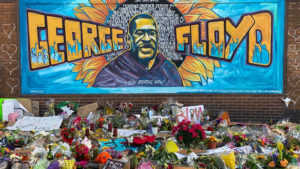
Courtesy Trevor Hughes/USA Today, Fair use image

